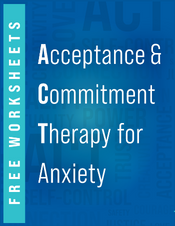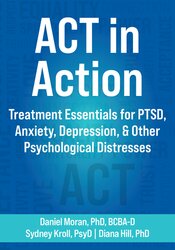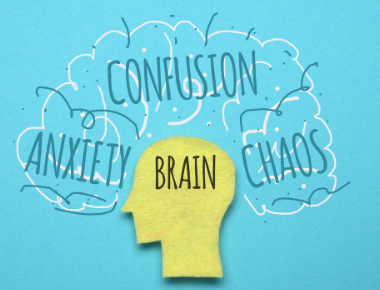Acceptance & Commitment Therapy for Anxiety
Free exercise to teach psychological flexibility

Clients often end up continuing their old behaviors that have kept them stuck in their attempts to avoid their anxiety. They get trapped in automatic pilot modes of thinking, of emotionally reacting, and of behaving that temporarily reduce their anxiety but inadvertently make things worse in the long run. They often find themselves banging their heads into metaphorical brick walls, and when the walls do not give way, they hit their heads harder, and then complain that their heads hurt. Or, when paths open up, they stay “hunkered down,” are unwilling to persist in moving forward.
This exercise helps clients systematically list and work through all the things they have attempted to do for their anxiety, with the purpose of helping them fully realize what has not been working. They come to realize that their attempts to control their thoughts and feelings contribute to the problems, not the solutions. This awareness helps them let go of old patterns, and fosters a sense of willingness to try something new for the sake of living a more fulfilling life. Our goal in doing this is to help the clients become more psychologically flexible.
Clients often come to us feeling stuck. The feeling of stuckness arises when things are rigid and inflexible. The opposite of stuckness is flexibility.
Psychological flexibility is defined by Steven Hayes as “contacting the present moment fully as a conscious, historical human being, and based on what the situation affords, changing or persisting in behavior in the service of chosen values.”
Contacting the present moment fully is important, because you can only be flexible in the here and now. If you are somewhere else in your head, you are lost in the realm of thought. Being fully present involves engaging your senses in what you are experiencing in this moment.
You must also be conscious and mindful to be flexible. Zoning out or trying to escape into another state of consciousness makes it impossible to be flexible.
Part of being human involves having a history. There is a context to who you are, and your history is part of who you are in this present moment. A few years ago, I wrote an entire book on The Sense of Self. I explored many different aspects of what it is that makes us feel like an independent self. In one chapter, I wrote about my work with neuropsychological testing. When I assessed individuals with neurocognitive disorders (dementia-like Alzheimer’s Disease), I found that people without a history had great difficulty with psychological flexibility.
The second part of the definition of psychological flexibility—“based on what the situation affords”—refers to the importance of paying attention to context. How can you know what to do, and be flexible enough to choose wisely, if you are not aware of how the situation is unfolding from moment to moment?
Once we recognize the situation as it is, and we know what we value, we can decide if it will be best to persist in an important behavior, or to change what we are doing in order to move toward what really matters.
Clients with anxiety tend not to be very psychologically flexible. When they feel anxiety, they want to avoid the situations that might cause it, or distract themselves. When they become more flexible, they can still choose to avoid unpleasant situations, but they can also choose to feel the anxiety and go ahead and do the things that make their lives more meaningful.
Tip for Clinicians: Practice being psychologically flexible yourself. Watch out for your own rigidity in how you interact with your clients. Be aware of ideas you might be fused with. Be willing to be confused and to feel your own feelings, as you are asking the client to do.
Click here to download your free resource today!

This is an adapted excerpt from ACT With Anxiety: An Acceptance and Commitment Therapy Workbook to Get You Unstuck from Anxiety and Enrich Your Life.
This exercise helps clients systematically list and work through all the things they have attempted to do for their anxiety, with the purpose of helping them fully realize what has not been working. They come to realize that their attempts to control their thoughts and feelings contribute to the problems, not the solutions. This awareness helps them let go of old patterns, and fosters a sense of willingness to try something new for the sake of living a more fulfilling life. Our goal in doing this is to help the clients become more psychologically flexible.
Psychological Flexibility
Clients often come to us feeling stuck. The feeling of stuckness arises when things are rigid and inflexible. The opposite of stuckness is flexibility.
Psychological flexibility is defined by Steven Hayes as “contacting the present moment fully as a conscious, historical human being, and based on what the situation affords, changing or persisting in behavior in the service of chosen values.”
Contacting the present moment fully is important, because you can only be flexible in the here and now. If you are somewhere else in your head, you are lost in the realm of thought. Being fully present involves engaging your senses in what you are experiencing in this moment.
You must also be conscious and mindful to be flexible. Zoning out or trying to escape into another state of consciousness makes it impossible to be flexible.
Part of being human involves having a history. There is a context to who you are, and your history is part of who you are in this present moment. A few years ago, I wrote an entire book on The Sense of Self. I explored many different aspects of what it is that makes us feel like an independent self. In one chapter, I wrote about my work with neuropsychological testing. When I assessed individuals with neurocognitive disorders (dementia-like Alzheimer’s Disease), I found that people without a history had great difficulty with psychological flexibility.
The second part of the definition of psychological flexibility—“based on what the situation affords”—refers to the importance of paying attention to context. How can you know what to do, and be flexible enough to choose wisely, if you are not aware of how the situation is unfolding from moment to moment?
Once we recognize the situation as it is, and we know what we value, we can decide if it will be best to persist in an important behavior, or to change what we are doing in order to move toward what really matters.
Clients with anxiety tend not to be very psychologically flexible. When they feel anxiety, they want to avoid the situations that might cause it, or distract themselves. When they become more flexible, they can still choose to avoid unpleasant situations, but they can also choose to feel the anxiety and go ahead and do the things that make their lives more meaningful.
Tip for Clinicians: Practice being psychologically flexible yourself. Watch out for your own rigidity in how you interact with your clients. Be aware of ideas you might be fused with. Be willing to be confused and to feel your own feelings, as you are asking the client to do.
Click here to download your free resource today!

This is an adapted excerpt from ACT With Anxiety: An Acceptance and Commitment Therapy Workbook to Get You Unstuck from Anxiety and Enrich Your Life.
Improve Client Outcomes with ACT!

Learn how to apply – and individualize – emotional regulation, mindfulness and cognitive behavioral strategies to treat clients with trauma, anxiety, depression, eating disorders, addiction, negative emotions and more. Earn Up to 12.25 CE Hours with leaders in Acceptance and Commitment Therapy!
Meet the Expert:
Richard W. Sears, PsyD, PhD, MBA, ABPP, has given hundreds of workshops on and ACT all around the world. He is a board-certified clinical psychologist in Cincinnati, Ohio, where he runs a private therapy and consultation practice, and is Director of the Center for Clinical Mindfulness & Meditation. He holds several academic appointments, including the Department of Clinical Psychiatry & Behavioral Neurosciences with the UC College of Medicine. Dr. Sears is also a psychologist contractor with the Cincinnati VA Medical Center and with Alliance Integrative Medicine.
Dr. Sears is author of over a dozen books, including ACT with Anxiety; The CBT & Mindfulness Toolbox and Mindfulness: Living Through Challenges and Enriching Your Life. He is also a sixth-degree black belt in Ninjutsu, and once served as a personal protection agent for the Dalai Lama of Tibet. He has a PhD in Buddhist Studies, and received ordination in three traditions, as well as recognition as a Zen master.
Learn more about their educational products, including upcoming live seminars, by clicking here.
Dr. Sears is author of over a dozen books, including ACT with Anxiety; The CBT & Mindfulness Toolbox and Mindfulness: Living Through Challenges and Enriching Your Life. He is also a sixth-degree black belt in Ninjutsu, and once served as a personal protection agent for the Dalai Lama of Tibet. He has a PhD in Buddhist Studies, and received ordination in three traditions, as well as recognition as a Zen master.
Learn more about their educational products, including upcoming live seminars, by clicking here.
Topic: ACT | Anxiety/Depression
Tags: ACT- Acceptance and Commitment Therapy | Activity | Anxiety | Free Resources | Therapy Tools | Tools





